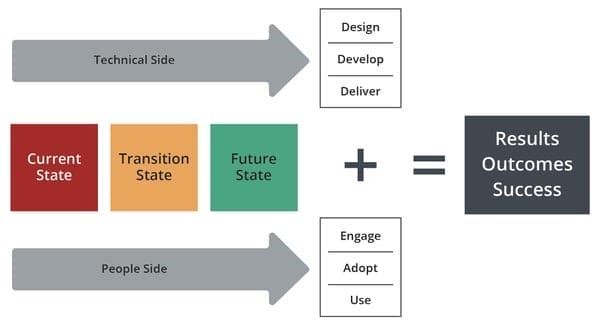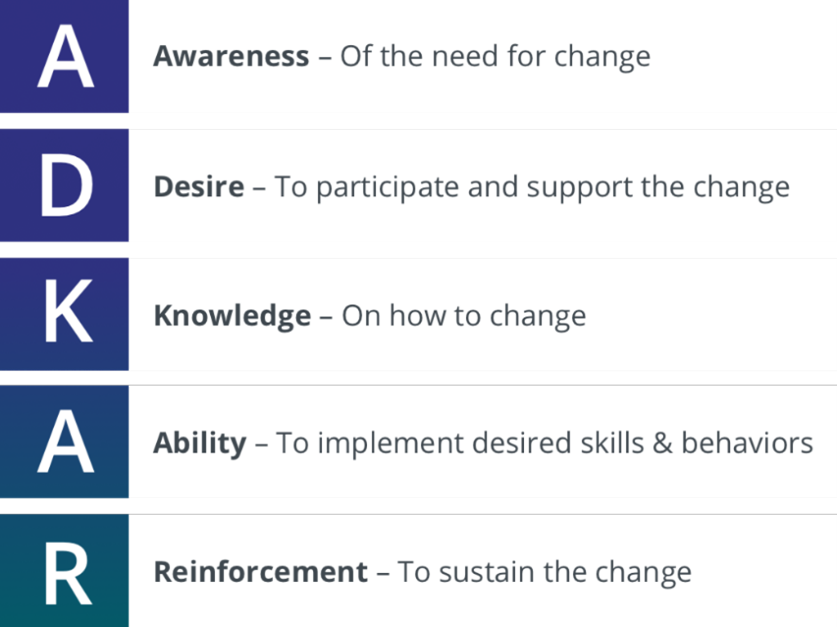Driving engagement with Process Management requires more than just telling your people that they must now be process driven.
Lets consider the Prosci change management model.

This clearly demonstrates the need to manage not just the technical side of change (documenting processes), but also the people side of change to enable a transition from the current state (work is done differently every time it’s done) to our desired future state (work gets done the same way, regardless of when or by whom its done).
The Prosci model tells us that, in order to move our people from their current state to our desired future state, we need to help them pass through ‘ADKAR’ barrier points.

The first ‘A’, Awareness requires effort but is relatively straight forward. As long as you create and diligently execute a communication plan it shouldn’t be too difficult to ensure that all your stakeholders are aware of your process management initiative.
More challenging though is progressing your stakeholders through the ‘D’ for Desire barrier point. If you ask the average person what process management means to them, often the answer they give will be some version of the word ‘bureaucracy’. So, how then do you get people excited about process management?
Here are my top five reasons for how organisations and teams benefit from process management:
- Standardisation and Stabilisation
When work is done differently every time it’s performed, the work is going to produce inconsistent outputs. The inconsistency of these outputs will almost always result in customer complaints, and therefore employees and managers will waste time fixing problems and pacifying upset customers. This means that, for managers, much of their time is spent reactively responding to issues, and for employees, there’s frustration as they struggle to meet their targets (let alone grow) which will result in turnover. As such standardisation and stability will make everyone’s life better – employees will have more clarity on how to do their jobs in such a way that they can keep their internal and external customers happy, and managers will have more time to be forward thinking, focusing on growth and development, which will further benefit their teams. I’ve done a deep dive on the importance of standardisation in this earlier blog post.
- Process Improvement and Automation
When we are no longer chasing our tail fixing issues, we can dedicate time to improving the way that we work. This could mean improving our processes with the objective of further increasing the quality and consistency of their outputs, or finding ways to produce the same quality of outputs faster and with fewer resources. Doing so will lead to an even better customer experiences, but also by removing the mundane parts of our jobs we (as employees) will have more time to spend doing the work that we enjoy and on stretch projects that accelerate our development.
If you start talking about streamlining and automation people may become concerned that this initiative is about a headcount reduction which will turn them into detractors rather than supporters. Positioning is therefore particularly important here, you need to make it clear that this is not about downsizing, rather clearly state the personal benefits your team will experience from these optimisation and automation initiatives.
- Training and Onboarding
The way that most organisation train today still seems to revolve hoping that new starters will learn by observing the way that existing staff work. This shadow based approach results in new starters picking up the bad habits of our existing team members, forgetting a significant amount of what they are taught, as well as delaying the new starters ramp to being productive. Ultimately, it moves us further away from achieving standardisation and stability.
By taking a process driven approach to onboarding, where new starters are taught with the aid of documented processes, we are teaching new starters the correct and agreed way of working from day one. This means that they are less likely to pick up bad habits and will have access to clear process guidance while they learn the process (we generally need to perform a process +/- 10 times before we commit it to memory). This approach also free’s up our existing staff members to get on with their day jobs as new starters can self-serve rather than having to seek assistance whenever they need a reminder on how things are done.
- Prevent process information walking out the door
When your process are undocumented, your processes don’t belong to your organisation, they belong to the people who work in your organisation. Aside from the problems associated with needing to rely on our long standing staff to answer questions whenever anyone has a question that starts with ‘How do I do….’, any day that these people leave the organisation they’ll take this knowledge with them.
In general, we need to build a culture where our processes are seen as assets of our business; we want our people to believe that one of the reasons why we will execute on our mission is because of the quality of our processes. If this is the case, it’s critical that our processes are formally documented so our ability to execute is not reliant on key individuals remaining within the organisation.
- Improved Risk Management
One of the biggest problems with the way that most organisations manage risk, is that risk management a seen as the responsibility of our risk managers. What we need is a culture where everyone in the organisation believes that risk management is part of their job which, in many cases, will simply mean doing their job by following the documented processes so that they perform all necessary controls/ treatments. By taking a process driven approach to risk management we’re able to change risk management from being a theoretical exercise to one that tangibly benefits the organisation.
This is also a topic that I have previously explored in detail which you can access here.
The final piece of advice that I have for you to effectively build desire across your organisation to engage with process management, is to consider who needs to deliver this message. Messaging certainly needs to come from your Executive Sponsor who should align process management with your organisation’s mission. Your people managers then need to take this overarching vision and deliver clear, targeted messaging on how this initiative will help the team and individuals achieve their specific objectives.
Coming back to the Prosci model, organisations don’t change, individuals change, so making sure each individual is clear on how process management will impact them personally is critical for your process management initiative to stick.
Digital Transformation Business Manager

